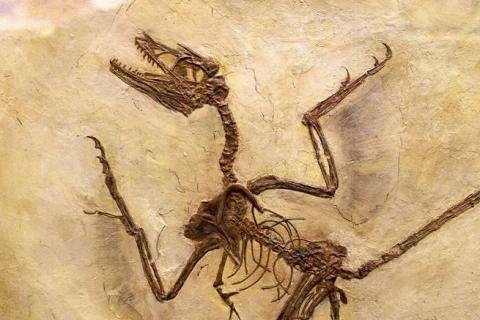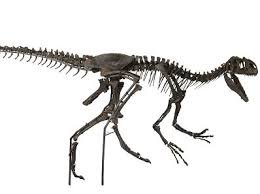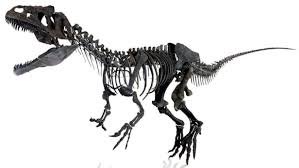Researchers Simply Found 125 million-year-old Dinosaur Dandruff::---------------
Aslam O Alikum, Hi,
How are you my steemit friends today?? I am fine and happy, Hope you will be fine and happy in their love life, As you know that i always try my best to bring a unique and informative content for my stemmit friend, My today,s post is about 125 million- year-old dinosaur, Let,s read the post......................

Another investigation distributed in Nature Communications represents the revelation of approximately 125 million-year-old dinosaur dandruff fossils. The discoveries aren't only a speedy reason for making a terrible Head and Shoulders joke, yet in addition really clarify a component by which dinosaurs accomplished something almost general: shed skin.
"Likely no one much considered how dinosaurs shed their skin previously," says Mike Benton, an educator of vertebrate fossil science at the University of Bristol and a coauthor of the new examination. The new discoveries "disclose to us that dinosaurs resembled winged animals, shedding their skin in little chips."
.jpg)
The discoveries originate from the examination of plumes from the Cretaceous time frame in China, from three distinctive dinosaur species (Microraptor, Beipiaosaurus, and Sinornithosaurus) and the prompt riser Confuciusornis. Benton and his partners had been working with the examples since 2007, and the portrayal of the skin chips is only their most recent turning point.
.jpg)
All creatures shed, or freed themselves of old skin and plumes and hair, so they can become bigger and new face ecological difficulties with a new layer of outside tissue. Before the new discoveries, there was a lack in seeing how dinosaur skin functioned and how the strong brutes figured out how to shed it. The most predominant hypothesis was that shedding in dinosaurs happened in pieces, as it does in their nearest current relatives (fowls and crocodiles). The entire sheath skin shedding method utilized by snakes and a few reptiles would have had less rhyme or reason for dinosaurs, given that these species are all the more indirectly related.
In any case, amid the gathering's work utilizing standard and electron magnifying instruments, the scientists continued going over odd white masses found everywhere throughout the plumage. Upon further examination utilizing particle pillar magnifying lens (which uncovered the inner structure of the chips), the group distinguished the bits as corneocytes: extreme cells made out of curved strands of keratin, found in both present day flying creatures and also human dandruff.
"We maintained a strategic distance from the word dandruff in the logical paper since it's a term generally connected to skin chips between the hair of people," says Benton. "Be that as it may, this is what we're seeing, caught between shafts of plumes in the fossil winged animals and dinosaurs. They are modest drops of surface skin, estimating 1 to 2 millimeters over." The group trusts dandruff most likely advanced amid the Middle Jurassic time frame, amid which there was a sprout in new padded dinosaur species.
Past the way that obviously dinosaurs would be humiliated to wear dark dress without a decent head clean, the detail of the skin structure from the fossil demonstrates to us the species examined "were warm-blooded, yet not as enormously as present day flying creatures," says Benton. Flying can create colossal measures of metabolic warmth, and cutting edge winged animals utilize skin shedding as way encourage evaporative cooling. The dinos, conversely, have all the more firmly stuffed corneocytes that are not as openly shed, so cooling through this component would have been more constrained. This proposes these dinosaurs most likely created lower measures of warmth amid flight, on the off chance that they could fly by any means.
Danny Barta, a relative science specialist at the American Museum of Natural History who was not included with the investigation, calls the discoveries "noteworthy, especially in light of the fact that we've never had such clear understanding into the skin of feathered dinosaurs previously."
"The investigation affirms one more shared element between non-avian dinosaurs and flying creatures, and it's especially energizing to see these likenesses rise in many areas of the life systems, the distance down to the microstructural level," Barta says.
Pushing ahead, Benton and his group need to broaden their investigation of quills and skin to other dinosaur examples and perceive how regular these highlights are, particularly in species that are all the more firmly identified with current feathered creatures. In any case, by and by, I'm trusting this paper is only the first in another field of concentrate concentrated on awful dinosaur cleanliness—and that the outcomes make it into the third "Jurassic World" film. Try not to imagine you wouldn't pay to see Chris Pratt and Bryce Dallas Howard fight against T. rex BO for 120 minutes.
Thanks for giving your precious time to read my content, if you like my post please upvote and comments my post,
I,ll be with you soon with my new informative post, thanks a lot my steemit community. Take care all of you.
nice informative post @yaseenkamboh, i always like such informative things,thanks for share on steemit platform, i upvote and follow you,
great post i like it and upvote you,, good job keep it up ,have a great day,
very unique post.. very informative. I really love to hear about the facts of Jurassic age.... great work. Expecting few more articles like this. All the very best.
thanks a lot for comments on my post dear friend,stay along with me forever take care ,God bless you all the time ,
thanks for comments dear friend & stay along with me for upvote each other